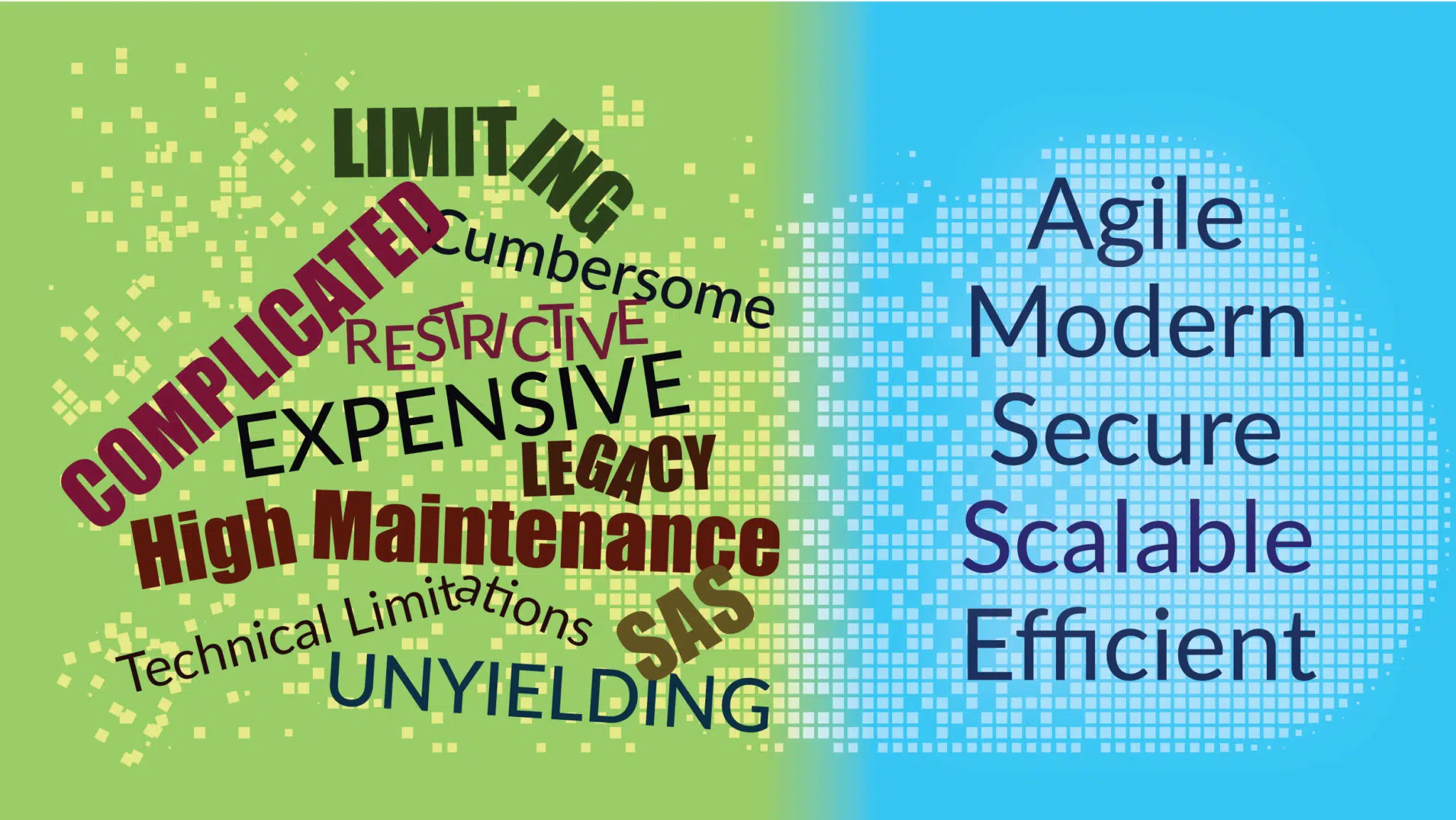Migrating Away from SAS – You Can Do It!
October 12, 2021

Statistical Analytics System (SAS) is software used for data analysis. It’s the most widely used data science platform across the globe, so if your organization uses it, you’re in good company. However, SAS is a legacy environment that many organizations find problematic. As with any mature legacy system with tentacles wending their way through an organization’s operating systems, a SAS environment requires a great deal of upkeep — to operate properly, it must be updated and upgraded frequently, which requires purchasing a lot of licenses, and that results in a high cost of ownership.
How Do You Reduce Your Reliance on SAS?
What executives often don’t realize is that there are not only many cloud platform options, but plenty of migration paths, all of which have their own benefits and levels of cost savings.
Why Do Organizations Migrate to the Cloud?
Most organizations cite seven main reasons behind their choice to migrate to the cloud. Read about those reasons here.
Different Migration Paths
- Replatform: This migration path requires very few changes to an organization’s existing legacy code. Instead, systems are simply redeployed to a new platform. Some businesses might choose this method as a proof of concept before undertaking a more complex migration method. It also could serve as a migration’s first phase, before shifting to a second.
- Refactor: In this migration path, a system’s general functionality is not altered, but legacy code is translated to the Python programming language, and technical debt, which is created when development decisions prioritize speed over design, is reduced. An organization may choose to stop at this point, or refactoring can be a step on the path toward total replacement.
- Replace: For a migration that implements a total platform replacement, legacy code is fundamentally rewritten in order to optimize and modernize an organization’s systems and allow them greater ability to innovate. This option requires decision-makers to take part in a Design Workshop, which helps them imagine the possibilities a modern platform would allow and choose the landscape that would best serve them.
What is PAM?
Prolifics literally wrote the book on migrating from a legacy system to a modern cloud architecture environment. Our experts created a business-sensitive Prolifics Agile Migration (PAM) process manual. This manual provides definition, formality and rigor around the process, and provides a jumping off point to create a unique solution for your organization.
Regardless of the path you choose, however, two things are evident: thorough testing is imperative, and Python must be the programming language used to build the new platform.
Why Does the World Love Python?
Python is an agile, sophisticated and robust open-source programming language widely used for data science, and it is the most downloaded one in the world. Dr. G opines that it is above and beyond SAS in data science, and he believes that any organization considering a move to modern cloud architecture has to make Python part of the equation. “The reality is that Python is eroding legacy scripting languages, like SAS,” he said. “These legacy scripting languages evaporate because they’re islands — they are not a part of an integrated system.”
Because it doesn’t require licenses and allows users to pick and choose only the pieces of code they need, Python offers the flexibility and cost savings that legacy scripting languages can’t.
FUN FACT: Legend says that when Guido van Rossum began to implement Python, he was reading scripts of the 1970s BBC television show “Monty Python’s Flying Circus,” which served as naming inspiration. Presumably, he thought “Python” was a better name than “Silly Walk.”
Let Prolifics Take Charge of Your Migration
Prolifics takes cloud migration, which seems to many organizations an insurmountable task, and breaks it down into a series of simple steps that will help your organization reach its modernization goals.
- Download the Prolifics Agile Migration (PAM) process manual, Prolifics’ business-sensitive approach to cloud migration
- Schedule one of our customized workshops — we offer a range of workshops that can do everything from help you dream of the possibilities that modernization offers to educate your team on how to effectively use the new operating system
- Have our experts walk you through the process
Connect with us at solutions@prolifics.com.
Who Is Dr. G?
Michael L. Gonzales, Ph.D., (Dr. G) is Prolifics’ chief data scientist and an active practitioner in the IT space with more than 30 years of industry experience. He specializes in the formulation of business analytics that give competitive advantages to global organizations. Dr. Gonzales is a successful author, industry speaker, published researcher and lifetime Mensa member.